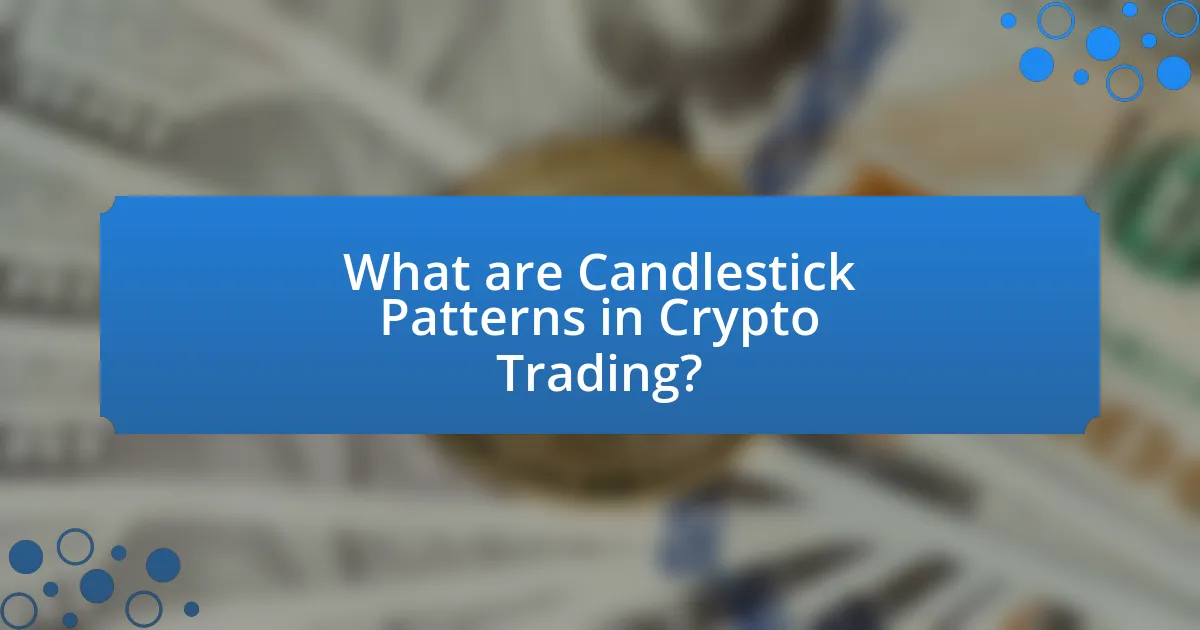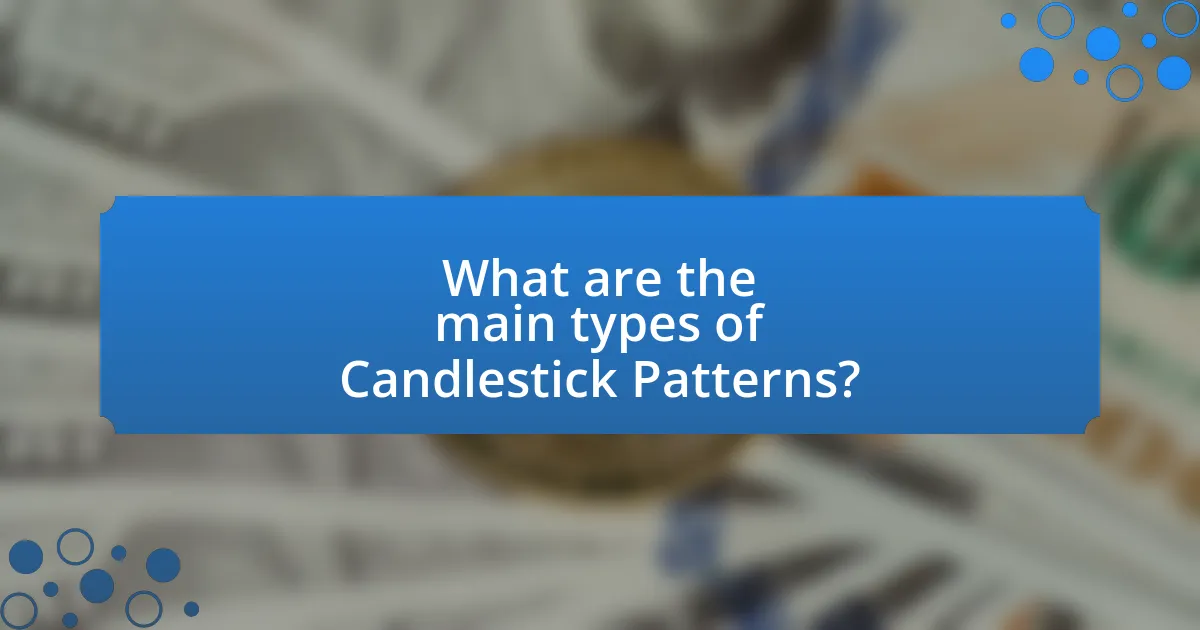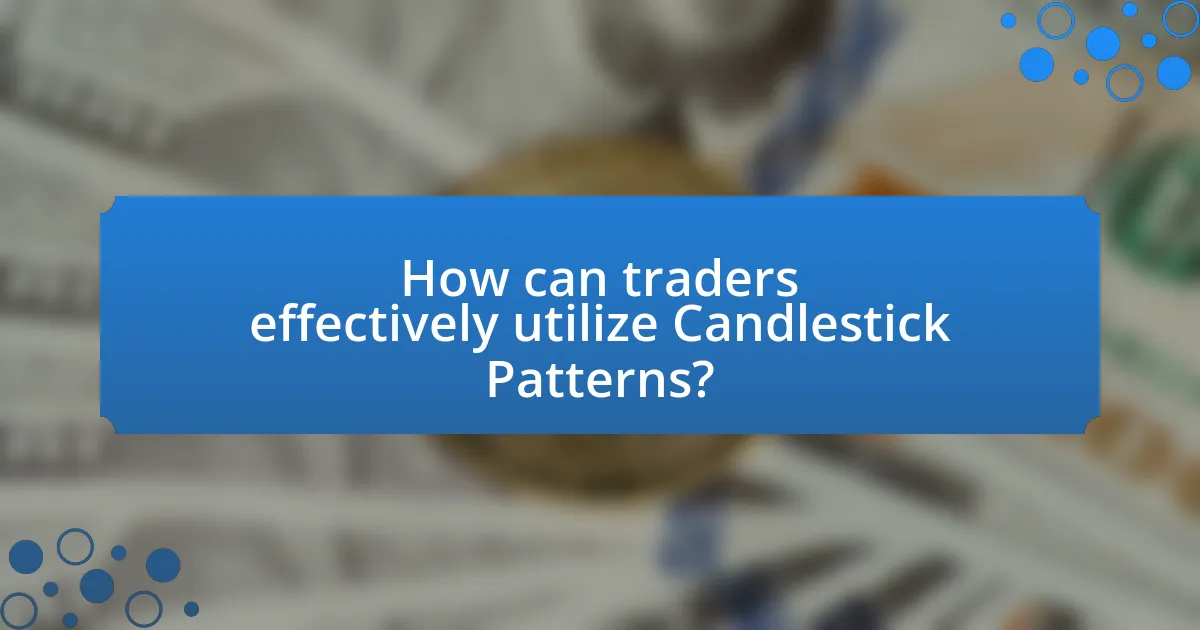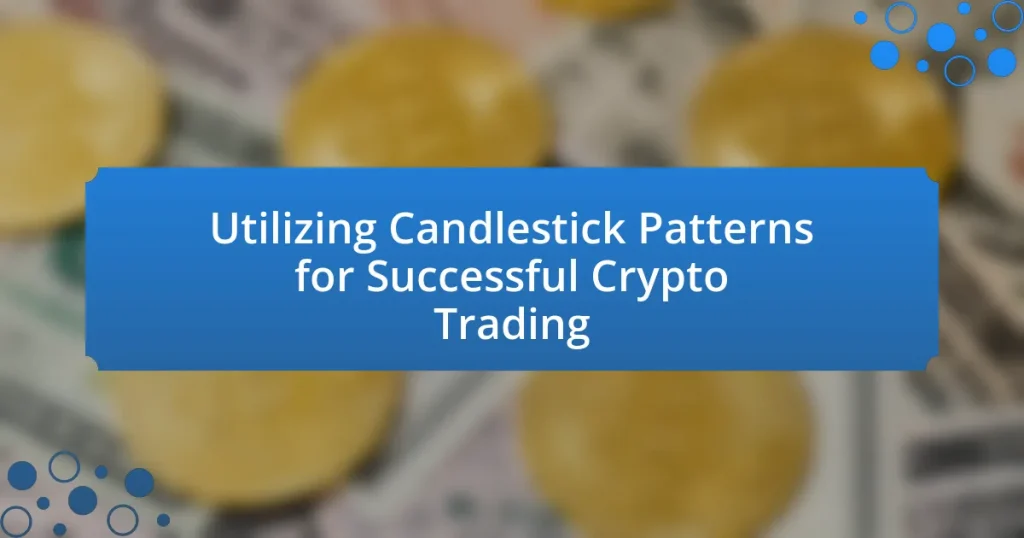Candlestick patterns are essential tools in crypto trading, providing visual representations of price movements that help traders analyze market trends and predict future price actions. Each candlestick consists of a body and wicks, indicating opening, closing, high, and low prices, which reflect market sentiment. The article explores various types of candlestick patterns, including single, double, and multiple formations, and their significance in identifying potential reversals or continuations in market trends. Additionally, it discusses the importance of volume in confirming these patterns, common mistakes traders make, and best practices for effectively utilizing candlestick patterns in trading strategies.

What are Candlestick Patterns in Crypto Trading?
Candlestick patterns in crypto trading are visual representations of price movements over specific time frames, used to analyze market trends and predict future price actions. Each candlestick consists of a body and wicks, indicating the opening, closing, high, and low prices within that period. These patterns, such as bullish engulfing or shooting star, help traders identify potential reversals or continuations in market trends, enhancing decision-making. Historical data shows that traders utilizing candlestick patterns can improve their trading strategies, as these patterns have been widely studied and documented for their predictive capabilities in various markets, including cryptocurrencies.
How do Candlestick Patterns represent market sentiment?
Candlestick patterns represent market sentiment by visually depicting the price movements and trading volume over a specific time period. Each candlestick reflects the open, high, low, and close prices, allowing traders to interpret bullish or bearish sentiment based on the shape and color of the candlestick. For instance, a long green candlestick indicates strong buying pressure and positive sentiment, while a long red candlestick suggests selling pressure and negative sentiment. Historical data shows that patterns such as doji, hammer, and engulfing patterns can signal potential reversals or continuations in market trends, thus providing insights into trader psychology and market dynamics.
What are the key components of a candlestick?
The key components of a candlestick are the body, the wicks (or shadows), and the open and close prices. The body represents the price range between the opening and closing prices, indicating whether the price increased or decreased during the time period. The wicks extend from the body and show the highest and lowest prices reached, providing insight into market volatility. Specifically, if the closing price is higher than the opening price, the body is typically filled with a lighter color, indicating bullish sentiment, while a darker color indicates bearish sentiment when the closing price is lower than the opening price.
How do different colors of candlesticks indicate market trends?
Different colors of candlesticks indicate market trends by representing price movements within a specific time frame. A green or white candlestick signifies that the closing price is higher than the opening price, indicating bullish sentiment and potential upward trends. Conversely, a red or black candlestick indicates that the closing price is lower than the opening price, reflecting bearish sentiment and potential downward trends. This color coding allows traders to quickly assess market conditions and make informed decisions based on the prevailing trend.
Why are Candlestick Patterns important for traders?
Candlestick patterns are important for traders because they provide visual insights into market sentiment and potential price movements. These patterns, formed by the open, high, low, and close prices over a specific time frame, help traders identify trends, reversals, and continuation signals. For instance, a bullish engulfing pattern indicates strong buying pressure, suggesting a potential upward price movement, while a bearish engulfing pattern signals selling pressure, indicating a possible downward trend. Historical data shows that traders who utilize candlestick patterns can enhance their decision-making process, as studies indicate that patterns like dojis and hammers can predict market reversals with a degree of accuracy, thus improving trading outcomes.
How do these patterns help in predicting price movements?
Candlestick patterns help in predicting price movements by providing visual cues about market sentiment and potential reversals or continuations in trends. These patterns, such as doji, hammer, and engulfing, indicate buyer and seller behavior, allowing traders to anticipate future price actions based on historical performance. For instance, a bullish engulfing pattern often signals a potential upward price movement, as it shows that buyers have overtaken sellers, which has been statistically observed in various market analyses.
What advantages do Candlestick Patterns offer over other trading indicators?
Candlestick patterns offer advantages over other trading indicators by providing clear visual representations of market sentiment and price action. These patterns allow traders to quickly interpret potential reversals or continuations in the market, which can lead to more informed trading decisions. Unlike many technical indicators that rely on lagging data, candlestick patterns reflect real-time market dynamics, enabling traders to react promptly to changes in market conditions. Additionally, candlestick patterns can be easily combined with other analysis techniques, enhancing their effectiveness in predicting price movements. Their historical significance in trading, dating back to the 18th century in Japan, further validates their reliability and widespread use among traders today.

What are the main types of Candlestick Patterns?
The main types of candlestick patterns include single candlestick patterns, double candlestick patterns, and multiple candlestick patterns. Single candlestick patterns, such as the doji and hammer, indicate market indecision or potential reversals. Double candlestick patterns, like the engulfing pattern and the harami, suggest stronger signals of trend reversals or continuations. Multiple candlestick patterns, including the morning star and evening star, provide insights into market sentiment over a series of sessions. These patterns are widely used in technical analysis to predict future price movements in various markets, including cryptocurrencies.
What are single candlestick patterns and their significance?
Single candlestick patterns are individual candlestick formations that provide insights into market sentiment and potential price movements. These patterns, such as the doji, hammer, and shooting star, indicate buyer or seller strength and can signal reversals or continuations in trends. For instance, a hammer pattern suggests a potential bullish reversal after a downtrend, while a shooting star indicates a possible bearish reversal after an uptrend. The significance of these patterns lies in their ability to help traders make informed decisions based on visual representations of price action, enhancing their trading strategies in the volatile cryptocurrency market.
How does a Doji candlestick signal indecision in the market?
A Doji candlestick signals indecision in the market by indicating that the opening and closing prices are virtually the same, reflecting a balance between buying and selling pressure. This formation occurs when neither buyers nor sellers gain control, often leading to uncertainty about the future price direction. The presence of a Doji suggests that traders are unsure about the market’s next move, which can precede a potential reversal or continuation of the current trend. Historical data shows that Doji patterns frequently appear at market tops or bottoms, reinforcing their role as indicators of indecision.
What does a Hammer candlestick indicate about potential reversals?
A Hammer candlestick indicates a potential bullish reversal after a downtrend. This pattern is characterized by a small body at the upper end of the trading range and a long lower shadow, suggesting that buyers have stepped in after sellers pushed prices lower. The presence of the long lower shadow demonstrates that there was significant buying pressure during the trading period, which can signal a shift in market sentiment. Historical data shows that when a Hammer appears at the bottom of a downtrend, it often precedes a price increase, reinforcing its role as a reversal indicator in technical analysis.
What are multi-candlestick patterns and their implications?
Multi-candlestick patterns are formations created by two or more consecutive candlesticks on a price chart, which traders analyze to predict future price movements. These patterns, such as engulfing, harami, and morning star, indicate potential reversals or continuations in market trends. For instance, a bullish engulfing pattern suggests a potential upward price movement following a downtrend, while a bearish harami indicates a possible downward reversal after an uptrend. The implications of these patterns are significant; they provide traders with insights into market sentiment and potential entry or exit points, enhancing decision-making in crypto trading.
How do Bullish and Bearish Engulfing patterns signal market trends?
Bullish and Bearish Engulfing patterns signal market trends by indicating potential reversals in price direction. A Bullish Engulfing pattern occurs when a small bearish candle is followed by a larger bullish candle that completely engulfs it, suggesting a shift from selling to buying pressure, often leading to upward price movement. Conversely, a Bearish Engulfing pattern appears when a small bullish candle is followed by a larger bearish candle that engulfs it, indicating a transition from buying to selling pressure, typically resulting in downward price movement. Historical data shows that these patterns have a high probability of predicting trend reversals, with studies indicating that Bullish Engulfing patterns can lead to a price increase of approximately 5-10% in the following days, while Bearish Engulfing patterns can result in similar declines.
What does a Morning Star pattern suggest about future price movements?
A Morning Star pattern suggests a potential reversal in price movements from a downtrend to an uptrend. This three-candle formation typically indicates that selling pressure is weakening and buyers are gaining strength. The first candle is a long bearish candle, followed by a smaller-bodied candle that can be bullish or bearish, and the third candle is a long bullish candle that closes above the midpoint of the first candle. Historical data shows that after the formation of a Morning Star, prices often rise, making it a reliable indicator for traders looking to capitalize on upward price movements in the market.

How can traders effectively utilize Candlestick Patterns?
Traders can effectively utilize candlestick patterns by analyzing the formations to predict market movements and make informed trading decisions. Each candlestick represents price action over a specific time frame, and patterns such as doji, engulfing, and hammer can indicate potential reversals or continuations in trends. For instance, a bullish engulfing pattern suggests a potential upward price movement, while a bearish doji may indicate indecision and a possible reversal. Historical data supports the effectiveness of these patterns; studies show that traders who incorporate candlestick analysis into their strategies can improve their win rates significantly, as patterns often reflect market psychology and sentiment.
What strategies can be employed using Candlestick Patterns?
Candlestick patterns can be employed in various trading strategies, including trend identification, reversal signals, and entry and exit points. Traders utilize patterns such as doji, hammer, and engulfing patterns to determine market sentiment and potential price movements. For instance, a bullish engulfing pattern often indicates a reversal from a downtrend, prompting traders to enter long positions. Conversely, a bearish engulfing pattern may signal a reversal from an uptrend, leading traders to consider short positions. Historical data supports the effectiveness of these patterns; studies show that traders who incorporate candlestick analysis can achieve higher win rates compared to those who do not.
How can traders combine Candlestick Patterns with other technical indicators?
Traders can combine Candlestick Patterns with other technical indicators by using the patterns to confirm signals generated by indicators such as Moving Averages, Relative Strength Index (RSI), or MACD. For instance, a bullish engulfing candlestick pattern occurring at a support level can be validated by an RSI reading below 30, indicating oversold conditions, which strengthens the buy signal. Additionally, if a candlestick pattern aligns with a crossover in Moving Averages, it can provide a more robust entry point. This method enhances the reliability of trading decisions, as it integrates multiple forms of analysis to confirm market trends and reversals.
What role does volume play in confirming Candlestick Patterns?
Volume plays a critical role in confirming Candlestick Patterns by providing validation of the price movement indicated by the patterns. High trading volume during the formation of a candlestick pattern suggests strong interest and conviction among traders, which increases the likelihood that the pattern will lead to a significant price movement. For instance, a bullish engulfing pattern accompanied by high volume indicates that buyers are actively entering the market, reinforcing the potential for upward price movement. Conversely, if a pattern forms with low volume, it may signal a lack of commitment, making the pattern less reliable. Historical data shows that patterns confirmed by volume tend to have higher success rates, as evidenced by studies indicating that patterns like the hammer or shooting star are more effective when supported by increased trading activity.
What common mistakes should traders avoid when using Candlestick Patterns?
Traders should avoid relying solely on candlestick patterns without considering the broader market context. This mistake often leads to misinterpretation of signals, as patterns can be influenced by external factors such as news events or market sentiment. Additionally, traders frequently overlook the importance of volume when analyzing candlestick patterns; high volume can validate a pattern, while low volume may indicate a lack of conviction. Another common error is failing to use stop-loss orders, which can result in significant losses if the market moves against the trader’s position. Lastly, traders often misjudge the timeframe of patterns, as a pattern that appears significant on a shorter timeframe may not hold the same weight on a longer timeframe.
How can over-reliance on patterns lead to trading errors?
Over-reliance on patterns can lead to trading errors by causing traders to ignore fundamental market conditions and other critical indicators. When traders focus solely on historical patterns, they may misinterpret market signals, leading to decisions based on outdated or irrelevant data. For instance, a study by the CFA Institute found that traders who relied heavily on technical analysis, including patterns, often failed to account for macroeconomic factors, resulting in a 30% higher likelihood of making poor trading decisions. This demonstrates that while patterns can provide insights, excessive dependence on them can obscure the broader market context, increasing the risk of errors.
What are the risks of misinterpreting Candlestick signals?
Misinterpreting candlestick signals can lead to significant financial losses in trading. Traders may make erroneous decisions based on false signals, such as mistaking a bullish reversal for a bearish one, which can result in entering or exiting positions at the wrong time. For instance, a study by the Journal of Finance indicates that incorrect interpretations of candlestick patterns can lead to a 30% decrease in trading performance. Additionally, reliance on candlestick signals without considering broader market context can exacerbate risks, as these patterns may not account for underlying trends or news events that influence price movements.
What are some best practices for successful trading with Candlestick Patterns?
Successful trading with candlestick patterns involves recognizing key formations, confirming signals with volume, and integrating patterns into a broader trading strategy. Traders should focus on identifying patterns such as doji, engulfing, and hammer, as these indicate potential market reversals or continuations. Confirmation through increased trading volume enhances the reliability of these signals, as higher volume often signifies stronger market conviction. Additionally, incorporating candlestick patterns with other technical indicators, like moving averages or RSI, can provide a more comprehensive view of market trends, improving decision-making. Historical data shows that traders who combine candlestick analysis with volume and other indicators tend to achieve higher success rates in their trades.
How can traders develop a disciplined approach to using Candlestick Patterns?
Traders can develop a disciplined approach to using Candlestick Patterns by establishing a clear trading plan that includes specific entry and exit criteria based on these patterns. This structured approach allows traders to make informed decisions rather than relying on emotions or impulsive actions. For instance, traders should define which candlestick patterns they will focus on, such as dojis or engulfing patterns, and set rules for when to enter a trade based on the confirmation of these patterns. Research indicates that traders who adhere to a systematic strategy are more likely to achieve consistent results, as evidenced by a study published in the Journal of Finance, which found that disciplined trading strategies significantly outperform random trading. By maintaining a trading journal to track performance and refine strategies, traders can further enhance their discipline and effectiveness in utilizing candlestick patterns.
What resources are available for further learning about Candlestick Patterns?
Books, online courses, and websites are valuable resources for further learning about Candlestick Patterns. Notable books include “Japanese Candlestick Charting Techniques” by Steve Nison, which is considered a foundational text in the field. Online platforms like Investopedia and BabyPips offer comprehensive guides and tutorials on candlestick patterns, making them accessible for traders at all levels. Additionally, platforms such as Udemy and Coursera provide structured courses that cover candlestick analysis in detail, often including practical examples and exercises. These resources collectively enhance understanding and application of candlestick patterns in trading.

